When Hoegaarden was still spontaneously fermented
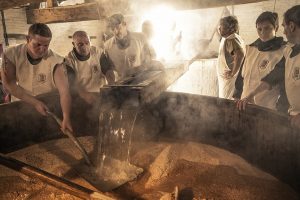 Spontaneous fermentation: magic words to anyone who loves wild, sour, aged beer full of brett, bugs and lactic acid. A method characterized by the fact that no yeast is actively added by the brewer. It’s mainly known for lambic, that wonderful Brussels beer which, after having aged for a few years, is used for making gueuze, faro and kriek. But what if I tell you that once there was another spontaneously fermented Belgian beer type, but one that was considerably different? One whose distant relative is still available on every corner in Belgium?
Spontaneous fermentation: magic words to anyone who loves wild, sour, aged beer full of brett, bugs and lactic acid. A method characterized by the fact that no yeast is actively added by the brewer. It’s mainly known for lambic, that wonderful Brussels beer which, after having aged for a few years, is used for making gueuze, faro and kriek. But what if I tell you that once there was another spontaneously fermented Belgian beer type, but one that was considerably different? One whose distant relative is still available on every corner in Belgium?
 Today, Hoegaarden is an inconspicuous village nestled in the rolling hills of the Haspengouw region, about 30 km south-west of Leuven, near the linguistic border. There is one very large brewery, which I’ll be speaking of later. But also in the past, this was a renowned brewing hub. In the Middle Ages, there still were some vineyards here, but from the 16th century onwards, Hoegaarden became well known for its beer. This may have had to do with its taste, but probably just as much with Hoegaarden’s position as an enclave of the Prince-bishopric of Liège right in the middle of the Duchy of Brabant. This meant almost excise-free brewing and exporting to Brabant. In the 18th century, the number of breweries rose to about 35, which meant an average of one brewery for every 67 inhabitants![1]
Today, Hoegaarden is an inconspicuous village nestled in the rolling hills of the Haspengouw region, about 30 km south-west of Leuven, near the linguistic border. There is one very large brewery, which I’ll be speaking of later. But also in the past, this was a renowned brewing hub. In the Middle Ages, there still were some vineyards here, but from the 16th century onwards, Hoegaarden became well known for its beer. This may have had to do with its taste, but probably just as much with Hoegaarden’s position as an enclave of the Prince-bishopric of Liège right in the middle of the Duchy of Brabant. This meant almost excise-free brewing and exporting to Brabant. In the 18th century, the number of breweries rose to about 35, which meant an average of one brewery for every 67 inhabitants![1]
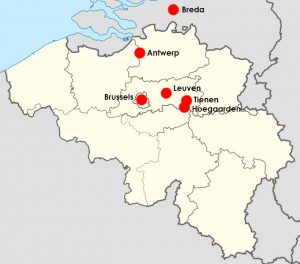 Hoegaarden’s beer was white beer (just as it is today, but more on that later), which was a beer type seen everywhere in Brabant. Leuven was also known for its white beer, as were Breda and Antwerp (seef) and it was made all over the countryside as well. White beer was mainly made of very light-coloured wind-kilned barley malt and unmalted wheat and oats. Sometimes spelt or buckwheat were used as well.[2] It was not unlike the kuit beer which the Belgians had copied from Dutch brewers in the 15th century, and probably white beer was derived from it.[3]
Hoegaarden’s beer was white beer (just as it is today, but more on that later), which was a beer type seen everywhere in Brabant. Leuven was also known for its white beer, as were Breda and Antwerp (seef) and it was made all over the countryside as well. White beer was mainly made of very light-coloured wind-kilned barley malt and unmalted wheat and oats. Sometimes spelt or buckwheat were used as well.[2] It was not unlike the kuit beer which the Belgians had copied from Dutch brewers in the 15th century, and probably white beer was derived from it.[3]
As far as we know, yeast was added to all these white beers, which was common practice anyway. As early as 1533-1534, yeast is mentioned as an ingredient for beer by the city council of Tienen, a town that also produced white beer.[4] There was however one exception: Hoegaarden. In 1829 the Leuven-based doctor of medicine and beer connoisseur Jean-Baptiste Vrancken mentioned that in Hoegaarden, brewers didn’t add yeast. French brewing engineer Georges Lacambre described the same in 1851.[5] An earlier description of brewing in Hoegaarden, from 1762, doesn’t mention yeast either.[6] Does this mean that the white beer of Hoegaarden was similar to lambic? Not really.
In Brussels, lambic is kept in the coolship for quite some time, and several days are allowed for fermentation to kick in. As said, it is only ready for drinking or processing after a few years. Not in Hoegaarden: the white beer there was meant to be consumed fast. It started fermenting quickly, and although fermentation itself was a bit slow, it was still drunk fresh. In summer, it already turned sour after 8 to 10, at best 15 days, after which it was undrinkable. Contrary to lambic, white beer was therefore brewed year-round.
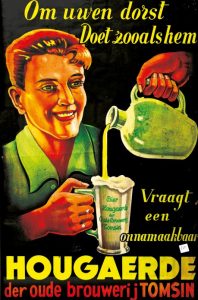 Lacambre describes it as ‘very pale, very refreshing, heavily foaming as long as it’s fresh; its raw taste has something wild to it.’[7] In fact, he looked a bit down on it: just like Leuven’s white beer, it still contained a lot of starch, which he thought was a sign of faulty brewing methods.
Lacambre describes it as ‘very pale, very refreshing, heavily foaming as long as it’s fresh; its raw taste has something wild to it.’[7] In fact, he looked a bit down on it: just like Leuven’s white beer, it still contained a lot of starch, which he thought was a sign of faulty brewing methods.
It is striking that a beer with such a short shelf life was exported to other cities and regions in such large quantities, as far as (East and West) Flanders and Holland. In Leuven, where a similar beer was made, white beer was often shipped before primary fermentation had even ended, and for some specific destinations they didn’t even add yeast, and relied on spontaneous fermentation as well.[8]
It makes you wonder whether the lambic of Brussels, which started life in the late eighteenth century, may have been inspired by the brewing methods of Hoegaarden in some way, but restyled as a keeping beer without oats.
In any case, in the 20th century Hoegaarden’s white beer quickly died out, because Belgians preferred pilsener, stout and other heavier beers that were made in a cleaner way. The last brewer that still produced it, Louis Tomsin, called it quits in 1957. (His much larger colleague Louriers, a.k.a. ‘Grandes Brasseries de Hougaerde’, continued brewing until 1972, but they had given up making white beer long before that. Their most well-known beer was Hougaerdse Das.) Tomsin’s brewing gear was taken to the Bokrijk open air museum, and that was that.
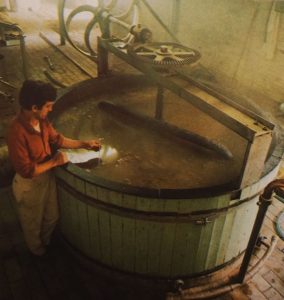 Or so it seemed. Tomsin’s neighbour, a milkman called Pierre Celis, still had an appetite for white beer. That’s why Tomsin scribbled down his recipe on a piece of paper, albeit incomplete: ‘I’ll tell you the rest when I see you.’[9] With that recipe, Celis got going. He got an old wine barrel and sawed it in two, got some brewing gear from Limburg, and started making what he called ‘Old Hoegaards’ beer: ‘velvet yellow and cloudy’.[10]
Or so it seemed. Tomsin’s neighbour, a milkman called Pierre Celis, still had an appetite for white beer. That’s why Tomsin scribbled down his recipe on a piece of paper, albeit incomplete: ‘I’ll tell you the rest when I see you.’[9] With that recipe, Celis got going. He got an old wine barrel and sawed it in two, got some brewing gear from Limburg, and started making what he called ‘Old Hoegaards’ beer: ‘velvet yellow and cloudy’.[10]
In Belgium, tradition has merged seamlessly with what we now call the ‘craft movement’, with several old small breweries managing to prolong their existence, like a few lambic brewers have. But Celis was the first to start with a blank slate. That’s how in 1966 Pierre Celis became Belgium’s first real ‘craft’ brewer: a small-scale start-up, with no respect for the well-accepted laws of commerce. As such, he still managed to build a large base of customers, and by doing so he saved white beer from oblivion. After a fire in 1985, he saw himself forced to sell the company to mega brewery Artois but he simply started over again elsewhere.
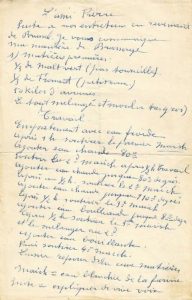 But did Celis use spontaneous fermentation? Actually, the version of white beer made by Pierre Celis and those that came after him, differs in many ways from the 19th century recipe. The oats, mentioned in Tomsin’s recipe and still used by Celis in the 1980s, have by now completely disappeared. The coriander and orange peel that today we think of as typical for white beer, are absent from the old Belgian white beer recipes and from Tomsin’s version.
But did Celis use spontaneous fermentation? Actually, the version of white beer made by Pierre Celis and those that came after him, differs in many ways from the 19th century recipe. The oats, mentioned in Tomsin’s recipe and still used by Celis in the 1980s, have by now completely disappeared. The coriander and orange peel that today we think of as typical for white beer, are absent from the old Belgian white beer recipes and from Tomsin’s version.
Also, Celis actively added yeast, although it was kind of wild: ‘Most other beers today are produced with cultured yeast, cultivated in laboratories. (…) Hoegaarden only is Hoegaarden because of its old natural yeast’. He compared his methods to the sour dough in bread. In any case, the fermentation was not spontaneous.[11] At the time, Celis’ white beer was still sweet and sour, tart, not pleasing to everyone’s palate. Under Artois and today AB InBev its taste just got more bland and plain every year. In any case, I doubt whether the coriander soup they serve today you on every Belgian terrace (with that irritating eternal slice of lemon) still really resembles the complex beer Celis started brewing in the 1960s.
Recipe for Hoegaarden’s white bier, after Georges Lacambre, 1851
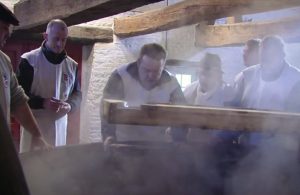 According to Lacambre, Hoegaarden’s white beer was made of 5 to 6 parts of wind-kilned (thus, very pale) barley malt, 2 parts of unmalted wheat and 1 to 1 1/2 parts of oats. He doesn’t give quantities, but if we calculate those given by Vrancken (1829), we get an original gravity of about 1.036 and a bitterness of 19 IBU. The attenuation level of white beer usually was only about 50%.
According to Lacambre, Hoegaarden’s white beer was made of 5 to 6 parts of wind-kilned (thus, very pale) barley malt, 2 parts of unmalted wheat and 1 to 1 1/2 parts of oats. He doesn’t give quantities, but if we calculate those given by Vrancken (1829), we get an original gravity of about 1.036 and a bitterness of 19 IBU. The attenuation level of white beer usually was only about 50%.
The type of brewery described here, used an open wooden mash tun with a filter at the bottom, into which grains and water could be poured. The mash tun didn’t have its own source of heat. There was a separate boiling kettle and several additional vessels where the different mashes could be kept apart. Cooling was done in large open coolships.
The grains were poured into the mash tun and cold (summer) or lukewarm (winter) water was added. From this, a first mash was drawn, by letting the wort run out underneath from the filter, and by spooning it out from above, using baskets (they would push baskets into the grains, the wort would flow into the baskets through the holes, after which the wort could be taken out with large spoons).
This first mash was kept apart. Onto the grain they would then pour boiling water, after which again wort was drawn out. This second mash was put into the kettle together with the first mash, and was brought to the boil.
The grains were used once again: more boiling water was poured onto it, and after stirring this was left to rest for 30 to 45 minutes, after which the wort was drained (third mash) and put into a separate vessel.
The grains were taken out of the mash, after which the tun and filter were cleaned. Then the grains were put in again. Onto this, the boiling wort of the first and second mash were poured, to have these filtered one last time. The filtered wort that came out of this was called ‘mees’.
While this was going on, the third mash was put into the kettle, were it was boiled for one hour and a half or two hours, with half a pound of old hops per barrel of beer.
Next, everything was put in the coolships to cool down, after which everything was put into the fermentation vessel together. Without adding yeast, it was then put in open barrels for fermentation.
The beer was drunk fresh; in summer it often went sour after 8 to 10 days, or at best 15 days.
[1] Martine Wuyts, “Het is maar een Hougaerde”. Een sociaal-economisch onderzoek naar de bierindustrie van Hoegaarden in de 18e eeuw, Leuven 1993, p. 13-17, 88-90.
[2] Cf. Roel Mulder, Verloren bieren van Nederland, Houten 2017, p. 174; http://lostbeers.com/a-recipe-for-antwerp-seef/, http://lostbeers.com/white-beer-from-etten-anno-1783/, http://verlorenbieren.nl/een-brouwtje-brabands-witbier-in-1820/, http://verlorenbieren.nl/verloren-bieren-30-peeterman/.
[3] Raymond Van Uytven, ‘Haarlemmer hop, Goudse kuit en Leuvense Peterman’, in: Arca Lovaniensis, jaarboek 1975, p. 334-351, hierin p. 349.
[4] J.P. Peeters, ‘Bieraccijnzen en bierproduktie te Tienen op het einde van de Middeleeuwen en in de 16de eeuw’, in: Eigen schoon en de Brabander, volume LXX nr. 1-3 (January-March 1987) p. 1-26 and volume LXX nr. 4-6 (April-June 1987) p. 155-180.
[5] Jean Baptiste Vrancken, ‘Antwoord op vraag 81’, in: Nieuwe verhandelingen van het Bataafsch Genootschap der Proefondervindelijke Wijsbegeerte te Rotterdam, Rotterdam 1829, p. 228-230; Georges Lacambre, Traité complet de la fabrication de bières et de la distillation des grains, pommes de terre, vins, betteraves, mélasses, etc., Brussel 1851, p. 372-374.
[6] Wuyts, “Het is maar een Hougaerde”, p. 19-21.
[7] Lacambre, Traité complet, p. 374.
[8] According to Vrancken, spontaneous fermentation was also used in Tienen: in summer, no yeast was added, in winter a relatively small amount of half a litre. Vrancken, ‘Antwoord’, p. 231.
[9] http://www.heemkring-hoegaarden.be/sites/default/files/bijlagen/In%20Memorium%20Pierre%20Celis.pdf
[10] Wilfried Patroons, Bier, Antwerpen 1979, p. 133-134.
[11] Dany van Cauwenbergh, ‘Het bleke bier uit Hoegaarden: de zuurzoete triomf van Pierre Celis’, in: Brabant, volume 1983, nr. 3, p. 56-59.






Rather late to the party on this, Roel, but if you look at Jeremy Banas’s book “Celis Beers”, published in the US last year, he reveals that Tomsin never added yeast to his wort, relying on the yeast left in the walls of the fermenting vessels (p28), which caused Pierre Celis som confusion when he started brewing himself in 1965, as he didn’t realise you were supposed to add yeast to the wort, having never seen Tomsin do that. He appears to be a bit of a fibber about the yeast: the original yeast he used came from the Loriers brewery, which was itself originally from Whitbread in London. Later he used the yeast from the Braserie Mont St Guibert, which was originally from Younger’s in Edinburgh …